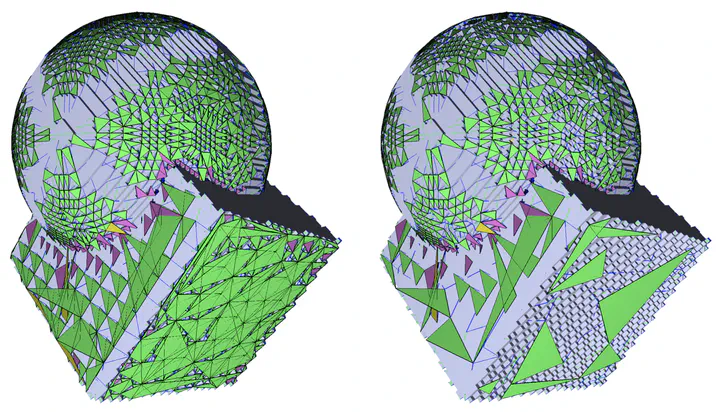Two Plane-Probing Algorithms for the Computation of the Normal Vector to a Digital Plane
Jan 1, 2017· ,,·
0 min read
,,·
0 min read
Jacques-Olivier Lachaud
X. Provençal
T. Roussillon

Abstract
Digital planes are sets of integer points located between two parallel planes. We present a new algorithm that computes the normal vector of a digital plane given only a predicate “is a point x in the digital plane or not”. In opposition to classical recognition algorithm, this algorithm decides on-the-fly which points to test in order to output at the end the exact surface characteristics of the plane.We present two variants: the H-algorithm, which is purely local, and the R-algorithm which probes further along rays coming out from the local neighborhood tested by the H-algorithm. Both algorithms are shown to output the correct normal to the digital planes if the starting point is a lower leaning point. The worst case time complexity is in O(ω) for the H-algorithm and O(ω log ω) for the R-algorithm, where ω is the arithmetic thickness of the digital plane. In practice, the H-algorithm often outputs a reduced basis of the digital plane while the R-algorithm always returns a reduced basis. Both variants perform much better than the theoretical bound, with an average behavior close to O(log ω). Finally, we show how this algorithm can be used to analyze the geometry of arbitrary digital surfaces, by computing normals and identifying convex, concave or saddle parts of the surface. This paper is an extension of Lachaud et al. (Proceedings of 19th IAPR international conference discrete geometry for computer imagery (DGCI’2016), Nantes, France. Springer, Cham, 2016).
Type
Publication
Journal of Mathematical Imaging and Vision, 59(1):23-39, 2017
Digital Geometry
Digital Planarity
Digial Plane Recognition
Normal Vector Estimation
Lattice Reduction
Plane Probing
Discrete Geometric Estimator
Parameter-Free Estimator
Authors
Professor of Computer Science
My research interests include digital geometry, geometry processing, image analysis, variational models and discrete calculus.